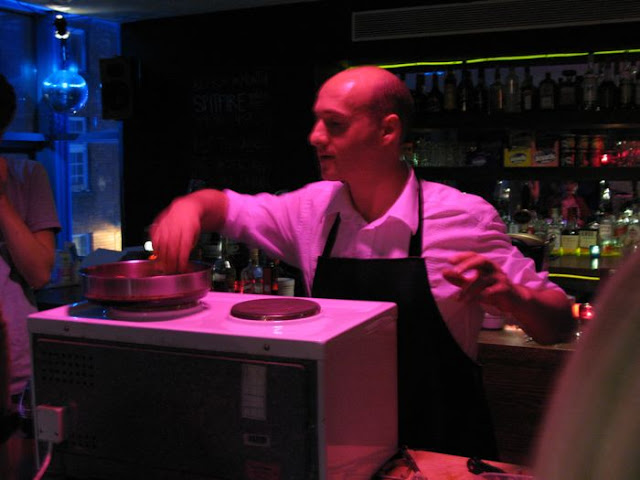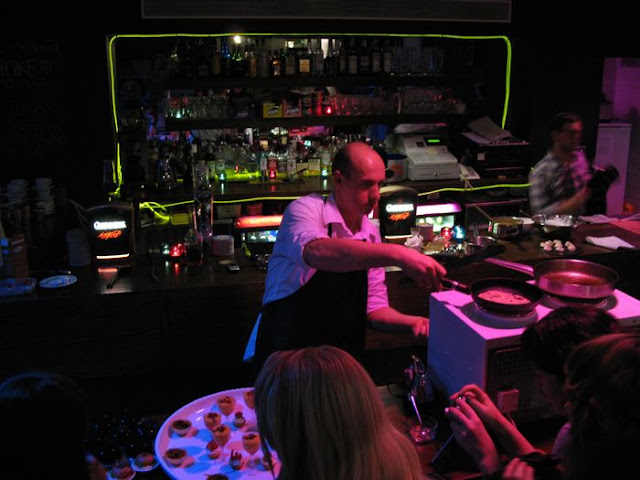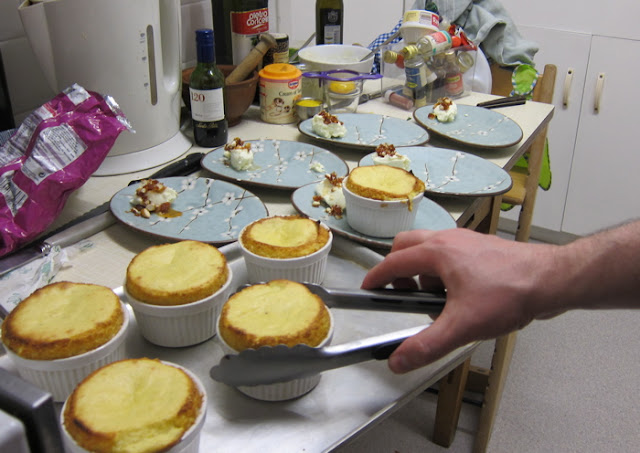Friday 8 June 2012
Elderflower fritters
Another brief glance of summer over the weekend past and with it the opportunity to cook something seasonal. I was in the west for the weekend where the elderflower was in full bloom and there's nothing more satisfying that getting your ingredients straight off the tree and for free. Elderflower has a wonderful heady fragrance of floral, fruity, vanilla honey that just makes you feel warm and rosy. You can make (or buy) elderflower cordial, which is a great thing to have in the storecupboard for perking up summer deserts and if I'm out of white wine when making a risotto, I'll make a glass of this up to use instead.
If you're fussy about eating insects I guess you could wash the flowers first. The batter for these was made with 100g of flower, 175g fizzy water and a tablespoon of sugar mixed till smooth and left to rest for 30 mins. A beaten egg white is then folded through just before frying. They’re then doused with sugar and devoured while still warm.
These fritters were fragrant and light and sugary, although some of the blossoms were stronger than others. So next time I think it would be worth smelling each blossom before picking to make sure only the most scented flowers make it into the batter.
And on the subject of smell - I attended the first ever Dublin Gastronomy Symposium this week where one of the speakers, a Jane Levi gave a fascinating paper on the subject of smell - read it here. Apparently the reason that our sense of smell is so closely linked to memory is that our oflactory bulb, the organ that receives whatever aromas float up our nostrils is in fact an inetgral part of our actual brain.
Saturday 2 June 2012
A Desert for Europe
It’s Eurovision time of year again. I’m a big fan of Eurovision – its more exciting than the fiscal treaty anyway. And it just so happens that a couple of years back I got the opportunity to devise a desert especially for the occasion. So when the rest of Europe was watching Dima Bilan wowing the crowds in Serbia with his winning song ‘ Believe’, I was preparing meringue swans, blue sparkling jellies, profiteroles, peach trifles and the likes. I’d been invited to partake in an event at the Project Art Centre called ‘A Symposium A Banquet’ where people with a particular talent or passion for one thing or another demonstrated this to an audience. My offering was to demonstrate the making of a desert. This was my Desert for Europe inspired by the Eurovision, an extravaganza with fire and bells, bereft of subtlety where less is not more … its just less!
Wednesday 30 May 2012
Italian
With the onset of summer something Italian seemed fitting.
 For starters - bruschetta with:
For starters - bruschetta with:
- tomato jelly and basil (it's just tomato, whizzed, with gelatin)
- anchovy and buffalo mozzarella
- aubergine and chili
Mushroom ravioli with truffle oil. There’s not much more to say here really.
This is a pea puree with a scallop.
The stuff sprinkled over the scallop is the orange roe from the scallop that’s been dried out in the oven and then ground up to a powder in a pestle and mortar. The green roll is langoustine rolled up in spinach (same technique as described in a previous blog post) and topped with some lumpfish roe. The sauce is made from boiling up the heads and shells of the langoustines in milk and frothing up with some butter and a hand blender.
This is just a piece of beef, a simple red wine jus and horseradish. The beef is 21 day, dry aged fillet purchased form O’Toole's of Terenure.
Most meat is wet aged which means it’s vacuum packed in plastic. This makes the aging process quicker and also retains all the moisture (weight) in the meat both of which are a big plus for the retailer but which don’t benefit the taste or tenderness of the meat. By contrast dry aged beef is hung for much longer. Moisture is evaporated from the meat which concentrates its flavour and the natural enzymes break down the connective tissue in the muscle, which leads to more tender beef. Dry aged meat is more expensive to produce in that it needs to be hung for longer and at near freezing temperatures which results in about a third of the weight being lost. Add to this the fact that it is only those higher grades of meat which are suitable for the process `(such as fillet or sirloin which have a higher proportion of evenly distributed fat). All thing considered its understandable why it costs more to buy this but it’s well worth the extra for a special occasion.
The piece I cooked weighed about 0.8kg. Seasoned and the seared all over in a very hot pan and then straight into a hot oven for 15 mins and then removed from the pan and left to rest wrapped in foil. To make the sauce I just deglaze the pan with red wine and whisked in cold butter to add gloss. For the horseradish just grate the root into crème fraiche and add a little white wine vinegar and seasoning to taste.
Salad and cheese to follow.
And for desert - apricot soufflé.
This was my first attempt at a soufflé. I had a kumquat soufflé recently in the Gordon Ramsey restaurant at Ritz Carlton which was pretty spectacular. It was the highlight of the meal and I've been looking for an excuse to have a crack at producing a soufflé ever since. My effort here was reasonably successful but a little overdone I think and not as light and risen as it might have been. I think my downfall was not sticking with one recipe. I'd started off with the intention of following Julia Child’s supposedly foolproof instructions including her detailed essay on whisking egg whites by hand with a pinch of cream of tartar - but at the last minute I decided to mix it up with another recipe I’d found online and another from Gordon Ramsey's Just Deserts. The base was a creme patisserie and the fruit puree came from dried apricots soaked overnight. For dusting the the buttered molds I made up a praline and blitzed it to a powder. Served up here with a scoop of sweetened mascarpone and a little more of the praline.
 For starters - bruschetta with:
For starters - bruschetta with:- tomato jelly and basil (it's just tomato, whizzed, with gelatin)
- anchovy and buffalo mozzarella
- aubergine and chili
Mushroom ravioli with truffle oil. There’s not much more to say here really.
This is a pea puree with a scallop.
This is just a piece of beef, a simple red wine jus and horseradish. The beef is 21 day, dry aged fillet purchased form O’Toole's of Terenure.
Most meat is wet aged which means it’s vacuum packed in plastic. This makes the aging process quicker and also retains all the moisture (weight) in the meat both of which are a big plus for the retailer but which don’t benefit the taste or tenderness of the meat. By contrast dry aged beef is hung for much longer. Moisture is evaporated from the meat which concentrates its flavour and the natural enzymes break down the connective tissue in the muscle, which leads to more tender beef. Dry aged meat is more expensive to produce in that it needs to be hung for longer and at near freezing temperatures which results in about a third of the weight being lost. Add to this the fact that it is only those higher grades of meat which are suitable for the process `(such as fillet or sirloin which have a higher proportion of evenly distributed fat). All thing considered its understandable why it costs more to buy this but it’s well worth the extra for a special occasion.
The piece I cooked weighed about 0.8kg. Seasoned and the seared all over in a very hot pan and then straight into a hot oven for 15 mins and then removed from the pan and left to rest wrapped in foil. To make the sauce I just deglaze the pan with red wine and whisked in cold butter to add gloss. For the horseradish just grate the root into crème fraiche and add a little white wine vinegar and seasoning to taste.
Salad and cheese to follow.
And for desert - apricot soufflé.
This was my first attempt at a soufflé. I had a kumquat soufflé recently in the Gordon Ramsey restaurant at Ritz Carlton which was pretty spectacular. It was the highlight of the meal and I've been looking for an excuse to have a crack at producing a soufflé ever since. My effort here was reasonably successful but a little overdone I think and not as light and risen as it might have been. I think my downfall was not sticking with one recipe. I'd started off with the intention of following Julia Child’s supposedly foolproof instructions including her detailed essay on whisking egg whites by hand with a pinch of cream of tartar - but at the last minute I decided to mix it up with another recipe I’d found online and another from Gordon Ramsey's Just Deserts. The base was a creme patisserie and the fruit puree came from dried apricots soaked overnight. For dusting the the buttered molds I made up a praline and blitzed it to a powder. Served up here with a scoop of sweetened mascarpone and a little more of the praline.
Wednesday 23 May 2012
Monkfish livers
If you’re lucky enough to come across any of these , snap them up. Monkfish livers are the foie gras of the fish world, except without the forced feeding, general cruelty etc. I picked these up in Wrights of Howth at the weekend and cooked them up for lunch as soon as I got home. Dusted in flour, fried in butter, toast, lemon, mmmm.
Subscribe to:
Posts (Atom)











































